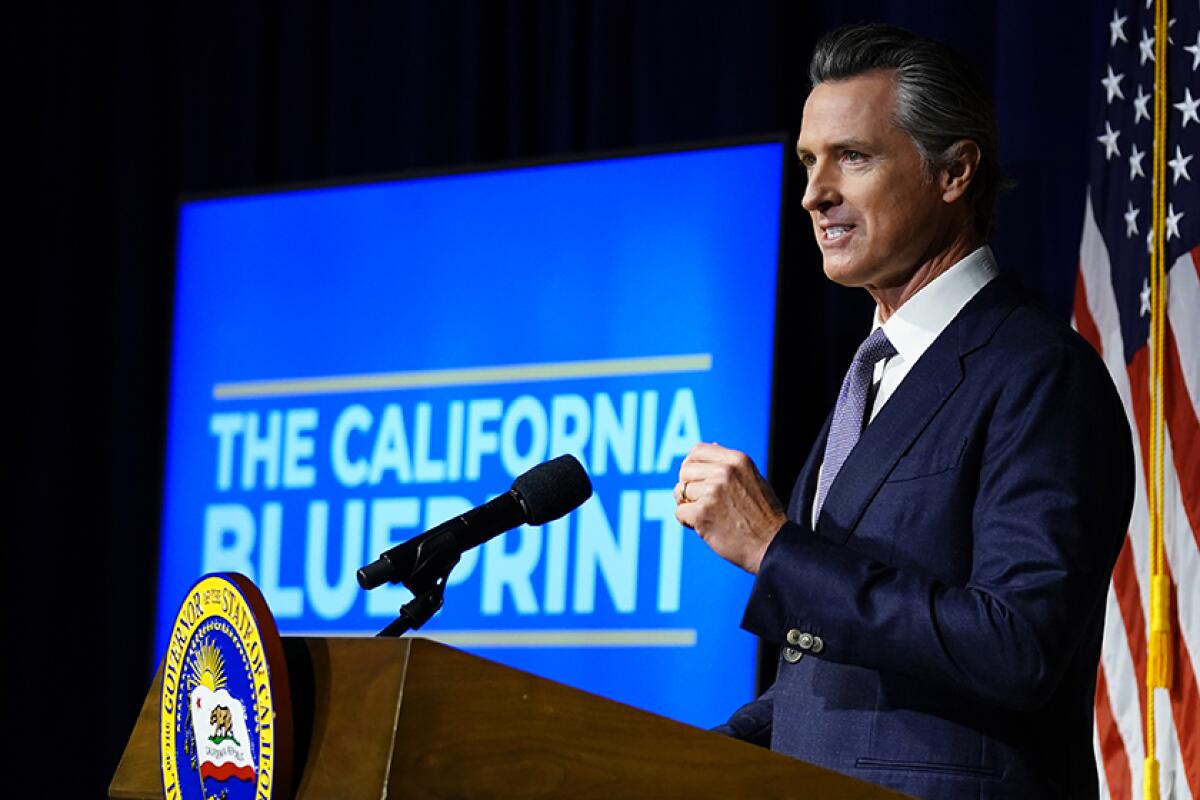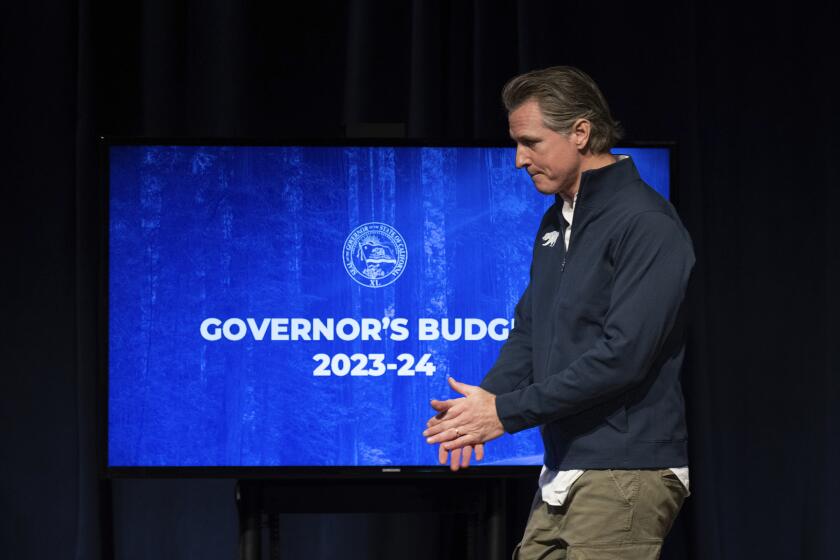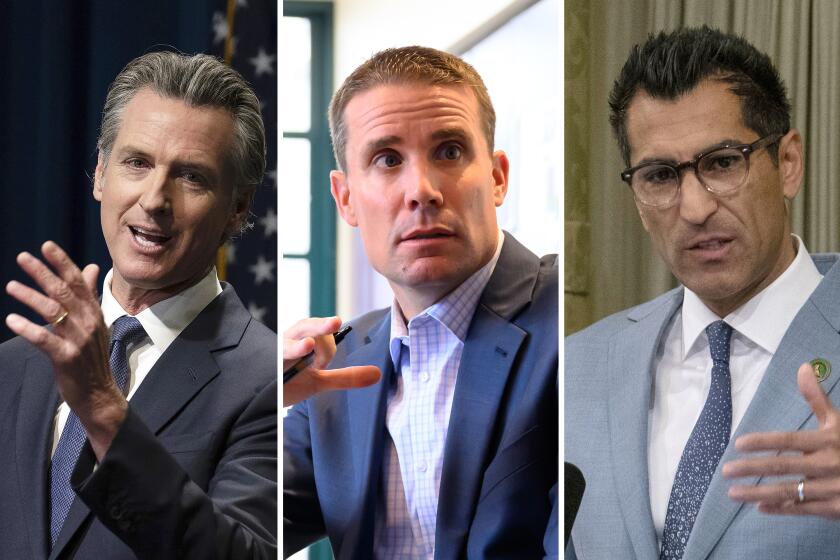Newsom, lawmakers use cuts, reserves and ‘fiscal emergency’ declaration to solve budget deficit

- Share via
Gov. Gavin Newsom and Democratic lawmakers struck a deal Saturday to make $16 billion in cuts, declare a statewide fiscal emergency and pull money from the state’s rainy-day reserves to balance a $46.8-billion budget deficit.
The agreement for a $297.7-billion spending plan is the result of weeks of contentious negotiations with labor unions and business interests after weaker-than-anticipated revenue forced Newsom and lawmakers to scale back California’s progressive policy agenda. The shortfall inspired a tug-of-war over coveted state dollars that has caused rifts between the governor and some of his closest allies at the Capitol.
Among the more high-profile changes, the 2024-25 budget plan delays a minimum wage increase for healthcare workers until at least October, cuts $1.1 billion for affordable housing and slashes $750 million in funding for the state prison system.
California’s business community also took a hit, with the three-year suspension of nearly $15 billion in tax breaks a year earlier than Newsom initially proposed.
“This agreement sets the state on a path for long-term fiscal stability — addressing the current shortfall and strengthening budget resilience down the road,” Newsom said in statement. “We’re making sure to preserve programs that serve millions of Californians, including key funding for education, health care, expanded behavioral health services and combating homelessness.”
The deficit marks a dramatic reversal of California’s financial standing from a projected $100-billion surplus two years ago and creates a challenging political narrative for Newsom, who often boasts of the state being an essential economic engine for the nation.
The governor is required by law to declare a statewide budget emergency before he can take money from the reserves to address the deficit. But an emergency declaration gives fodder to critics who have accused Democrats of mismanaging the state’s finances and overspending.
Despite the shortfall, the California economy remains strong, and the state has more revenue to spend than it did when Newsom took office.
“This is not a revenue problem,” said David Crane, president of Govern for California, a nonprofit that seeks to oppose the influence of labor unions on state government. “The deficit is a result of expenditures.”
In April, Newsom touted the fact that the California economy held its position as the fifth largest in the world, saying the state “continues to punch above its weight.”
The state government’s financial problem can be blamed in part on poor revenue projections that led Newsom and lawmakers to allocate more money for programs than they had available to spend.
The state’s progressive tax structure leaves government dependent on revenue from income taxes paid by chief executives and other top earners, which are subject to stock-market fluctuations and difficult to predict. Additionally, the delay of the 2022 tax filing deadline from April to November forced California leaders to craft the current budget without a full understanding of how much state tax revenue had declined.
Newsom anticipated California’s deficit to grow when he signed the budget last year and said he dedicated much of the new money in his spending plan to one-time funding increases that he could easily halt if revenue were to fall. The cuts include $500 million for a loan program to fund affordable student housing at colleges and a reduction of $485 million for work-study programs.
Yet the governor and lawmakers have been criticized for choosing to pull money from the state’s rainy-day fund — $5.1 billion in 2024-25 and $7.1 billion planned the following year — to avoid deeper cuts. Democrats also plan to take $900 million from a safety-net reserve account next year.
Tapping into the state’s piggy bank now has raised concerns about what could happen to programs serving California’s neediest if the economy falls into recession and revenue drops even lower.
Democrats at the Capitol released a broad overview of some of the cuts the Legislature will vote on next week, before the budget takes effect July 1.
Newsom and lawmakers said the agreement includes proposed legislation requiring the state, in the future, to set aside surplus funds for subsequent budget years as a means to protect against revenue swings and a constitutional amendment in 2026 to increase the rainy-day fund. Details were not shared with the announcement.
Here’s what we know so far about the agreement.
Pushing off a healthcare minimum wage hike
Newsom signed a bill into law last year to give healthcare workers a minimum wage increase to $25 per hour. He waited a few weeks to explain that he wouldn’t allow the law to take effect if the state budget crisis worsened.
At the time, the Department of Finance estimated that the law could cost the state $2 billion. Labor unions said the cost was closer to $300 million, if the state required hospitals to cover much of the expenditure.
Newsom’s concerns, which he said he shared with unions before he signed the law, set off months of private negotiations over when to raise wages and how to pay for the increase.
Those talks ended with the budget agreement, which delays the pay hike from taking effect until Oct. 15 at the earliest, instead of this month, as originally planned.
The start date for the pay hike hinges on one of two scenarios: state revenue in the first quarter of the fiscal year coming in 3% above projections, or more federal funding for hospitals through a quality-assurance fee. If neither happens, the increase could be delayed beyond October.
Lawmakers and the governor are essentially using the quality-assurance fee as a mechanism to ensure that hospitals can pay for the increase. Hospitals pay quality-assurance fees; the federal government matches the money, then remits the funding back to hospitals.
The federal increase requested by the state is expected to cover 30% of the cost of higher wages for hospitals.
The budget pegs the state’s cost for the program at $600 million in 2024-25.
Dave Regan, president of SEIU United Healthcare Workers West, said “workers are disappointed” that the wage hike won’t kick in this summer but recognized that legislative leaders and Newsom listened to the union’s concerns despite the shortfall.
Gov. Gavin Newsom said his staff has been working with Democrats in the Legislature on the state’s healthcare minimum wage law in light of budget concerns.
No solution on battle over MCO tax
The question of how to use the proceeds of a tax on managed care organizations, known as the MCO tax, turned out to be the most difficult to answer in budget negotiations — so challenging, in fact, that talks fizzled out, and Newsom threatened to oppose a ballot measure backed by some of his closest allies.
The tax applies to health insurance providers that charge fixed monthly payments for services and acts as a mechanism to allow California to collect billions in additional federal funds for Medi-Cal, the healthcare system for low-income residents.
Newsom and lawmakers renewed the tax last June and agreed to use some of the proceeds to raise reimbursement rates to providers who serve Medi-Cal patients. For years, doctors have waged an unsuccessful campaign to raise rates, arguing that the reimbursements are too low, result in a shortage of doctors willing to accept patients and restrict access to care.
But Newsom reversed course and proposed taking more than $6 billion from the Medi-Cal rate increases over multiple years and using the funding instead to avoid cuts to the program.
The change pitted Newsom against a coalition led by the California Medical Assn. and Planned Parenthood, two groups that have supported the governor’s causes and backed his campaigns.
The coalition called for the governor to stick to the agreement he made in 2023 to raise rates for providers. It also is leading a charge to pass a measure on the 2024 ballot that would permanently establish an MCO tax to fund higher reimbursement rates and other Medi-Cal services.
The governor wants the coalition to take the measure off the ballot. He wants the funds to be flexible so the state can use the money if necessary to support the Medi-Cal system in the future.
The coalition has so far declined to take the measure off the ballot, fearing that Democrats would divert the funding again. The talks ended in a stalemate.
The final state budget includes $6.9 billion next year to support the Medi-Cal system.
Newsom and lawmakers agreed to offer a smaller pot of money for “provider rate increases and investments” from the MCO tax, but far less money than was previously set aside. The budget includes $133 million in 2024-25 and a plan to raise that to $728 million in 2025-26 and $1.2 billion the following year.
Democrats said the MCO funding would become “inoperable,” essentially eliminated, if the measure is approved on the 2024 ballot.
Jodi Hicks, chief executive of Planned Parenthood Affiliates of California, said the tenets of the ballot initiative were negotiated last year with safety-net providers and policymakers. The coalition’s measure, if approved in November, would provide the state $2 billion for general Medi-Cal costs, outside of rate increases, annually in 2025 and 2026.
“The intent of the initiative was to make historic investments in the Medi-Cal program and provide for a generational change for patients and how they experience access to care,” Hicks said.
The governor threatened to campaign against the measure as the budget talks soured this year, setting up the possibility that he could challenge his supporters in the November election.
California officials must finalize the state budget and the list of measures that will go on the ballot by the end of June. Secret budget conversations are intertwined with deal-making around the 2024 ballot.
A pause on business tax breaks
The budget deal limits total tax credits for businesses in the state to $5 million per filer and pauses a net operating loss tax deduction for businesses with income of more than $1 million in 2024, 2025 and 2026.
In a concession to the business community, Newsom and lawmakers are allowing companies to receive refunds for the tax credits after the limits end.
Newsom originally proposed halting and capping the tax breaks beginning in 2025. But Democrats in the Legislature pushed to apply the changes a year earlier, allowing them to avoid cuts to other programs.
The administration said the changes to the tax breaks will increase revenue by nearly $15 billion through 2026.
The early start could hurt businesses who were planning to deduct losses from their 2024 taxes and now have to scramble to scale back on employees or inventory to cover the cost of an unexpectedly higher bill. The limit also marks the second time in five years that the state has capped tax credits, which could turn away companies that operate in California.
Big cut to prisons
Lawmakers previously proposed an additional $1 billion in cuts to the Department of Corrections and Rehabilitation, including at least $12 million in reductions to the governor’s project to transform San Quentin. Newsom’s proposed cuts had included $80.6 million in savings from the newly announced deactivation of 46 housing units at 13 state prisons.
The final agreement drops funding for corrections by $750 million through next budget year, which includes $400 million from Newsom’s plan to cut state operations and eliminate vacant jobs. Overall, the budget reductions to operations and personnel across all of state government saves nearly $2.2 billion.
Gov. Gavin Newsom and Democratic lawmakers work to settle their differences over a few key budget cuts to reduce California’s massive deficit.
Newsom supports another round of homelessness grants
In late May, Democrats in the Legislature proposed spending $1 billion more than the governor had budgeted on a sixth round of Homeless Housing, Assistance and Prevention grants to local governments. At the same time, lawmakers proposed cutting $100 million in funding to clean up homeless encampments in the current budget year.
The final budget deal appears to show a compromise.
The deal includes $1 billion in additional homelessness grants, which the governor and lawmakers said would be tied to new accountability measures to make sure local governments use the funding appropriately. The agreement also provides $150 million next year for encampment grants.
Broadband internet access for all — a little later
The COVID-19 pandemic exposed the need to improve access to broadband internet in homes across California when K-12 education shifted from the classroom to remote learning. Low-income families and those who live in rural areas often lack the same level of connectivity as more wealthy communities.
Newsom has sought to make internet access more equitable under a “broadband for all” initiative.
The spending plan delays $550 million in funding for “last mile” work, which connects the network to homes, until the 2027 budget year. The budget agreement still offers $250 million next year for a program to expand and improve the fiber-optic network under “middle-mile” projects, and Democrats intend to provide a total of $2 billion for last-mile work over multiple years.
A funding delay for public schools
Under Proposition 98, approved by voters in 1988, California has a minimum funding guarantee for schools and community colleges.
This year, Newsom proposed an unusual maneuver to re-characterize funding in 2022-23 to reflect the lower-than-expected state revenue.
The California Teachers Assn. said the change would have reduced funding for schools by about $12 billion over two years. The union ran a television ad criticizing Newsom’s proposal to pressure him to reverse course.
Newsom and teachers agreed late last month to a complicated solution that suspends the minimum funding guarantee and delays $5.5 billion in funding until future years.
More to Read
Sign up for Essential California
The most important California stories and recommendations in your inbox every morning.
You may occasionally receive promotional content from the Los Angeles Times.














